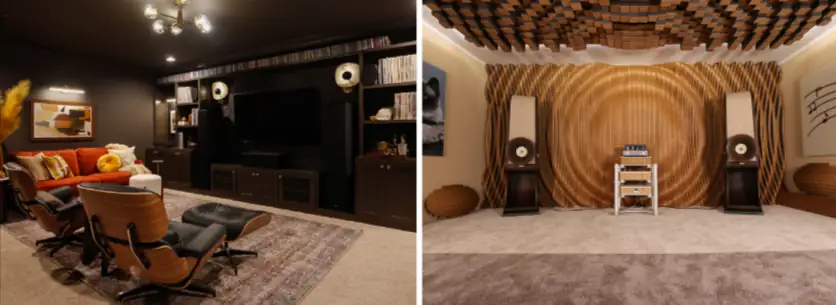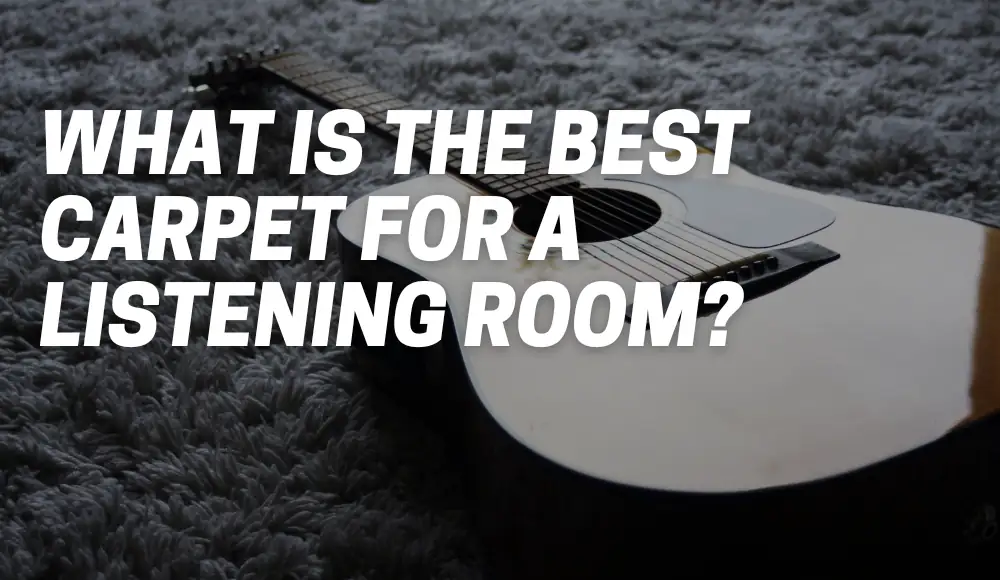Last updated on November 2nd, 2023 at 12:35 am
When it comes to crafting the ultimate listening room, audiophiles and movie enthusiasts alike know that every aspect of the environment matters. From the painstakingly chosen audio equipment to the meticulous arrangement of furniture, the goal is clear: to create a space that delivers an unparalleled auditory and cinematic experience.
Amidst all these considerations, one element that often doesn’t receive the attention it deserves is the choice of carpet.
However, don’t underestimate the impact of the right carpet in your quest for acoustic excellence.
In this guide, we’ll embark on a journey through the realm of carpets for listening rooms, delving into their influence on sound quality, the varieties that excel in acoustics, and invaluable insights from the vibrant communities of online forums and Reddit.
Should a Listening Room Have Carpet?
Close your eyes for a moment and envision this scenario: you’re seated in your meticulously designed listening room, poised to indulge in your favorite album or dive into an immersive movie experience.
The music starts to flow, and to your dismay, you’re confronted with an unintended resonance or an echo that disrupts the pristine clarity of the audio.
Enter the unsung hero of acoustic ambiance: the carpet.
Carpets possess a remarkable ability to absorb sound and minimize those pesky reflections that can mar your audio immersion. The physics at play are fascinating – when sound waves hit a solid surface, they tend to bounce and reflect, ushering in those unwelcome echoes. Here’s where the carpet comes to the rescue, diffusing these reflections and resulting in an environment that wraps you in a natural and captivating soundscape.

What Type of Carpet Absorbs Sound Best?
Now that we’re on board with the idea of a carpeted listening room, let’s dive into the details of what makes a carpet truly acoustic-friendly.
The effectiveness of sound absorption in carpets boils down to the intricacies of their construction. The type of carpet fiber, the height of the pile, and the overall density are pivotal factors in determining how well a carpet can absorb sound.
Generally, carpets endowed with thick and dense piles prove their mettle in sound absorption. Among the materials that take center stage are wool and nylon, celebrated for their acoustic prowess.
Yet, it’s wise to tread the middle ground; opting for a carpet with a medium pile height serves as a sweet spot, balancing both effective sound absorption and foot-friendly comfort.
—
Does Carpet Absorb High Frequencies?
As enthusiasts contemplate the prospect of carpeted acoustics, a recurring question surfaces: do carpets gobble up those essential high frequencies that bestow clarity and intricacy upon audio?
Thankfully, the realm of physics has our back here.
High frequencies, the gleaming jewels of audio intricacy, tend to elude the clutches of soft surfaces such as carpets. While carpet diligently absorbs mid and low frequencies, providing an admirable grip on bass resonance and flutter echoes, the ethereal high-frequency sounds retain their luster, dancing freely in the room.
Carpet possesses the ability to capture high frequencies, although this form of absorption doesn’t always align with the balance we seek within our rooms.
This translates into an environment where you can revel in the wonders of improved acoustics while retaining the sparkling brilliance of high-frequency sound.
Does Carpet Have a Sound Rating?
When navigating the realm of carpets, you might find yourself wondering about sound ratings – a vital concern for the discerning listener.
A sound rating – Sound Transmission Class or STC – refers to a measurement or assessment that quantifies the acoustic performance of a material, space, or system. It indicates how effectively a particular element can attenuate, absorb, or transmit sound waves.
Sound ratings are crucial in evaluating the potential impact of various factors on the acoustics of a room or environment, helping individuals make informed decisions to achieve desired sound quality, insulation, or noise reduction.
While dedicated sound ratings aren’t commonplace in the carpet universe, a subset of manufacturers does offer carpets engineered with acoustic performance in their DNA.
Enter the scene: “acoustic carpets,” a breed designed to dazzle with their sound absorption prowess.
These sonic virtuosos often arrive with specifications that outline their sound absorption coefficients. When hunting for the perfect carpet to grace your listening room, casting your lot with products tested and approved for acoustic performance is a wise move, endorsed by audiophiles who insist on nothing short of sonic perfection.
Is Carpet or Hardwood Better for Listening Room?
Enter the age-old conundrum, one that echoes through interior design circles and finds its way into the world of listening rooms: carpet or hardwood?
The appeal of hardwood floors lies in their aesthetic elegance and ease of maintenance.
Yet, the reflective tendencies of hardwood surfaces pose a challenge to acoustics, turning them into resonant mirrors that bounce sound waves. This is where carpet emerges as the victor in the acoustic arena.
By absorbing sound waves, carpet takes the reins in curbing reflections, culminating in a soundscape that wraps you in warmth and sonic purity.
What Is the Best Carpet for Acoustics?
Now that we’re committed to the carpet cause, the question arises: which carpet types are the champions of acoustics?
As you embark on your quest for the ultimate carpet, remember to keep the pile density, material, and pile height at the forefront of your considerations.
- Wool carpets, revered for their innate acoustic prowess, shine as sound-absorption virtuosos.
- Don’t overlook loop pile or cut and loop pile carpets either – their intricate structures often translate into commendable acoustic performance. These carpets strike a harmonious balance, marrying comfort with sound absorption, earning accolades from aficionados.
What Is an Acoustic Carpet?
If the concept of “acoustic carpets” tickles your curiosity, rest assured that it’s more than just a fanciful term.
Acoustic carpets are the result of a harmonious union between carpeting and sound absorption principles. With their high pile densities and carefully chosen sound-absorbing materials, these carpets shine as acoustic wizards.
Though the label “acoustic carpet” might not yet grace every flooring aisle, manufacturers attuned to sonic needs do offer carpets tailored to elevate room acoustics, promising an immersive auditory experience that resonates with perfection.
What Kind of Rugs Absorb Sound?
As you sculpt your listening room’s sonic sanctum, don’t dismiss the strategic prowess of rugs.
While fully carpeting a room is one option, rugs – those versatile, aesthetic delights – also have a role to play.
Area rugs, especially those swathed in dense fibers and cushioned backings, can work wonders in absorbing mid and high frequencies, taming echoes, and reflections.
Consider placing these audio allies in prime reflection points or beneath your seating arrangement, paving the way for controlled acoustics without committing to wall-to-wall carpeting.
What Is the Best Rug for a Listening Room?
If rugs have captured your attention, the next step is to select the crème de la crème for your listening room’s acoustic playground.
When perusing the offerings, keep an eye out for rugs boasting dense piles, natural materials like wool, and a pile height that strikes a harmonic chord. The world of Persian rugs unveils intricate patterns and dense weaves that contribute to effective sound absorption, infusing your space with both acoustic harmony and aesthetic grandeur.
For those seeking a touch of whimsy, the shaggy rug realm, with its elongated piles, beckons, offering a cozy cocoon for sound waves to revel in.
Is Carpet or Vinyl Better for Soundproofing?
While the spotlight often shines on sound absorption, the sibling concept of soundproofing seeks to stifle sound’s escape from your auditory haven.
Vinyl flooring steps onto the stage here, wielding its mass as a powerful sound barrier. Its weightiness renders it a formidable opponent in thwarting sound transmission, making it an ideal choice for those concerned about sound escaping their listening room and disturbing the peace beyond.
However, keep in mind that while vinyl excels in sound blocking, it lags behind carpet in the realm of sound absorption within the room.
What Is the Best Carpet for a Listening Room: Reddit and Forums Advice
In the vast realm of online experiences and insights, Reddit and forums emerge as vibrant communities where users eagerly share their knowledge and advice.
When it comes to unearthing the best carpet for your listening room, these digital landscapes offer gems of wisdom. Threads brim with personal anecdotes and experiences, shedding light on various carpet types, brands, and materials.
While opinions might diverge, a common chord resounds: wool carpets with medium pile height emerge as triumphant contenders, celebrated for their prowess in elevating room acoustics.
The recurring theme? Balancing the trifecta of aesthetics, foot-friendly comfort, and auditory excellence.
| Main Points |
|---|
| Carpet keeps everyone happy. |
| Wall-to-wall carpet or large throw rugs can work. |
| Consider acoustical materials that are both functional and visually appealing. |
| Suggests flat weave Berber-style carpet with quality padding. |
| Natural wool carpet is preferable over synthetics. |
| Suggests using a nice Persian rug in front of the speakers. |
| Wool carpets have natural sound qualities, but humidity might be a concern. |
| Prefers laminate floors for easy cleaning, but not ideal for sound. |
| Recommends area rugs and acoustic panels with engineered flooring. |
| Wall-to-wall carpet or large throw rugs suggested. |
| Shares negative experience with laminate floors for sound quality. |
| Recommends laminate floors due to cost, ease of cleaning, and appearance. |
| Advises against wooden floors on concrete slabs due to moisture concerns. |
| Wall-to-wall carpet over concrete is effective. |
| Suggests natural deeper pile rugs for better sound absorption. |
| Prefers using rugs on original wooden flooring with soft furnishings. |
| Shares positive experience with a wool rug for over 15 years. |
| Recommends thicker pile, real wool rugs for better sound and wear resistance. |
| Suggests thick pile wool rugs for improved acoustics. |
| Larger rugs are better, cover near reflection points between speakers and LP. |
| Appreciates the absence of micro plastics in wool rugs. |
FAQs
What is the best flooring for a music listening room?
While the allure of hardwood floors is undeniable, the crown for acoustic supremacy in a music listening room often rests on the heads of carpets and rugs. Wool carpets, particularly those with a medium pile height, garner enthusiastic endorsements for their acoustic properties, enveloping the space in a cocoon of sonic excellence.
Conclusion
As the curtain descends on our expedition through the world of carpets for listening rooms, one thing remains abundantly clear: the right carpet can orchestrate a symphony of sound quality, curating an environment that celebrates every nuanced note and immersive cinematic experience.
Yet, remember that the path to acoustic nirvana isn’t uniform. The perfect carpet choice will emerge from the intricate dance of your room’s peculiarities, your individual preferences, and your unwavering commitment to marrying aesthetics with acoustic mastery.



